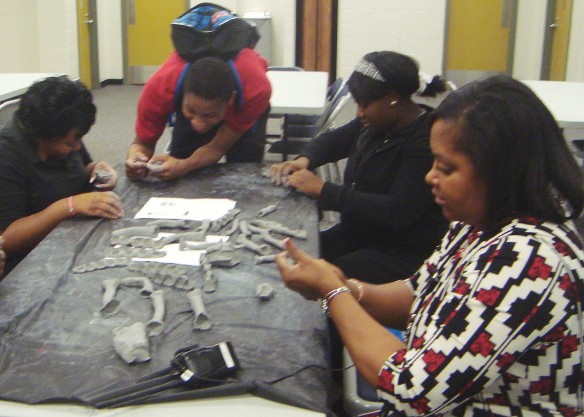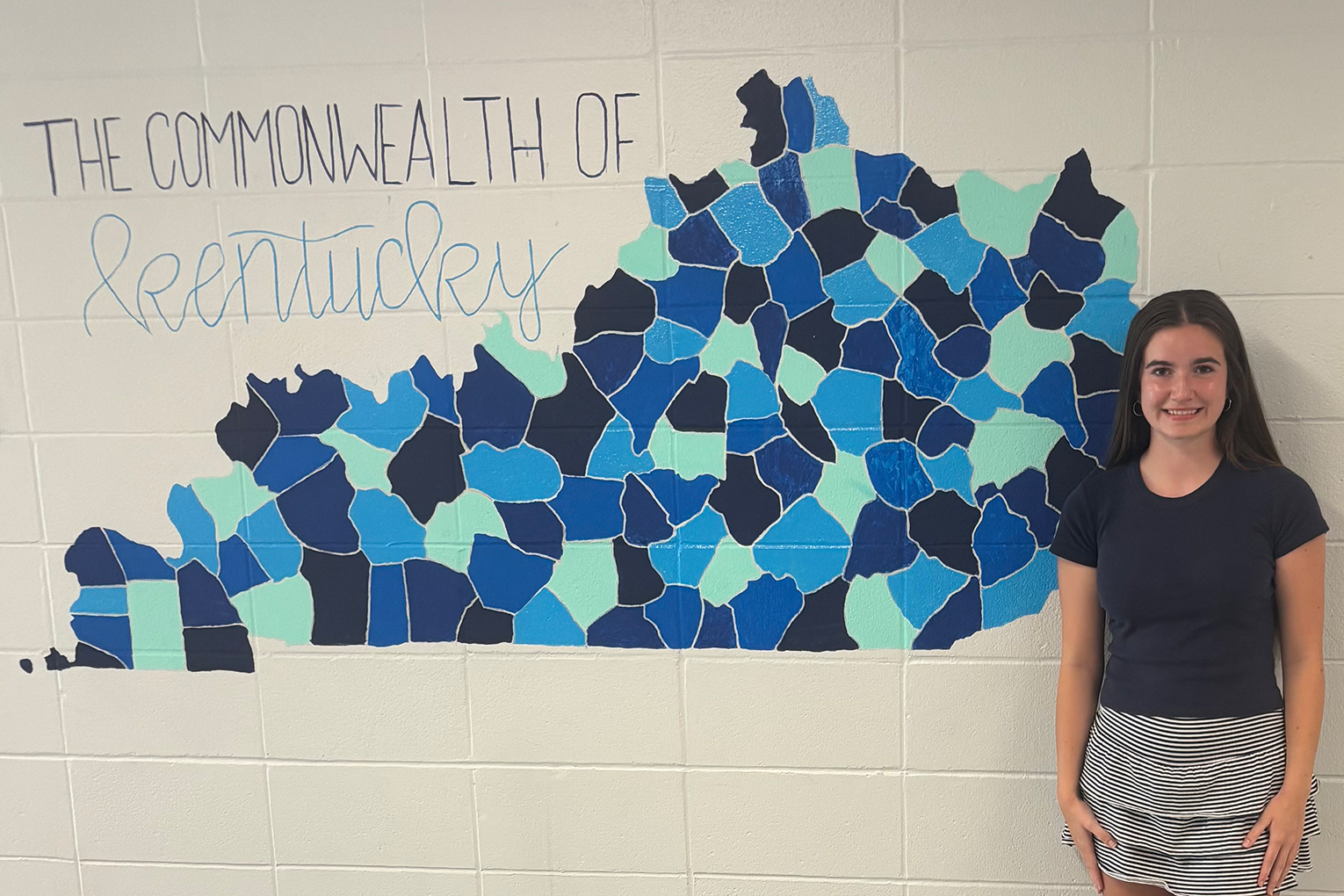
Seneca High School Principal Michelle Dillard molds clay bones with students as part of the One Million Bones project.
Photo submitted
By Matthew Tungate
matthew.tungate@education.ky.gov
Seneca High School art teacher Beverly Silletto had helped students create the clay bones for their public service project raising awareness of genocide. She’d helped gather them and helped put them in her two kilns.
But it wasn’t until she and her students were ready to remove the bisque ware bones that the project really hit home for them.
“When you opened up the kiln, the first things you saw were white bones – and they really do look like bones,” Silletto said. “It is so moving just to open that kiln and see that. The first time I saw that it made me gasp, and it made me think of concentration camps with all those bones.”
Students at multiple schools in the Jefferson County school district, including Louisville Male High, Olmsted Academy South and Seneca High, participated in One Million Bones. The national project raises awareness of genocide by encouraging students and artists to create clay bones that will be placed on the National Mall in Washington, D.C., in June.
Seneca students created 3,057 bones, the most in the district. Each bone will generate a $1 donation through the Students Rebuild organization to support humanitarian relief and rebuilding work in Central Africa.
Teresa Ohlmann, small learning community coordinator at Seneca, said the project was a collaboration between International Seminar and art classes. International Seminar incorporates social studies, geography and culture to better help students understand the world, she said.
Ohlmann said she regularly receives information about service-learning projects, and she thought One Million Bones would be a good match for not only the International Seminar and art classes, but the whole school.
Seneca has a 78 percent free and reduced-price meal rate, so fundraising is difficult for students, she said. But with Students Rebuild donating a $1 for each bone, it was “a dollar they might not be able to give, but they could do the work.”
Stephanie Ikanovic, who teachers International Seminar and social studies, said the appeal of the project was obvious from the start.
“It’s hard to pass up – you make some bones and you’re making money to give to people,” she said. “It’s almost a no-brainer.”
But first, Ohlmann, Ikanovic and Andrea Gieszl, an International Seminar teacher, wanted to teach the students about genocide so they would see the relevance of the project.
Gieszl said one of the goals of the class it to make students more globally aware.
“For a lot of them, they’ve never even been outside of Louisville, so to just become aware of the fact there iS a world outside of theirs, it’s connected to theirs, and allows them to connect with it on a more personal level,” Gieszl said. “So many times when you just look in books or you just see something on the Internet, it doesn’t seem as real as with a project like this where they realize that every bone they made was actually worth something and going to genuinely help someone.”
Gieszl said most students understand the concept of genocide through studying the holocaust.
“But that’s the problem: For a lot of them, it’s fossilized,” she said. “They think it’s something that happened, and they’re not aware that this is something that’s always happened and is an ongoing thing now, too.”
So she approached genocide also as a current events unit, looking at places like Darfur in Sudan.
Ikanovic, whose Bosnian husband was 15 years old when he fought in the country’s civil war that included genocide, said she spent six weeks teaching about different genocides.
Gieszl said the most important lesson the students learned was that they can make a difference in the world.
“It’s not just learning about it, it’s doing something about it. They have the ability to make the difference, and they did,” she said.
When it came time to make the bones, students were very motivated, Ohlmann said.
“There was a real purpose when they started making those bones,” she said. “They understood what they were doing it about.”
Right before winter break, students and teachers spent three or four class periods making bones in the human skeleton. They built the bones from chunks of clay on pizza boxes.
Silletto said she helped show students how to work the clay to make the bones, and they were allowed to use handouts of bones from different parts of the body, like the hands and feet.
“So even if the students were not art students, they were getting art instruction at the same time,” she said.
One of the International Seminar students made all 27 bones in the human hand, Silletto said.
Once they were done, it took close to two weeks with two kilns going non-stop for more than 24 hours per set of bones.
The finished bones fill 15 boxes.
Ohlmann said she hoped the students would make 1,500 bones “and the kids went so far beyond that.”
“We not only helped people, but we made ourselves feel good about ourselves,” she said.
Besides making the bones, Seneca students participated in a two-day teleconference with students in Somalia, in partnership with One Million Bones and Students Rebuild.
Ohlmann said Seneca students come from 42 countries, including Somalia. But there was something different for the students in talking to students while they were in another country, she said.
As students began to converse, Ohlmann said she was impressed by questions students asked and the questions they answered.
“Here’s how I knew they were into it: because they were silent and listening,” she said.
Gieszl said it was good for students to have a connection to real people and to help put a face on the project they had completed.
Ikanovic said the video conference also helped students realize how lucky they are to live in the United States. Students were especially struck when they heard Somali students say how their lives were improving because they had running water, could go to school and could feel safe walking around.
MORE INFO …
Teresa Ohlmann, teresa.ohlmann@jefferson.kyschools.us, (502) 485-8323




Leave A Comment